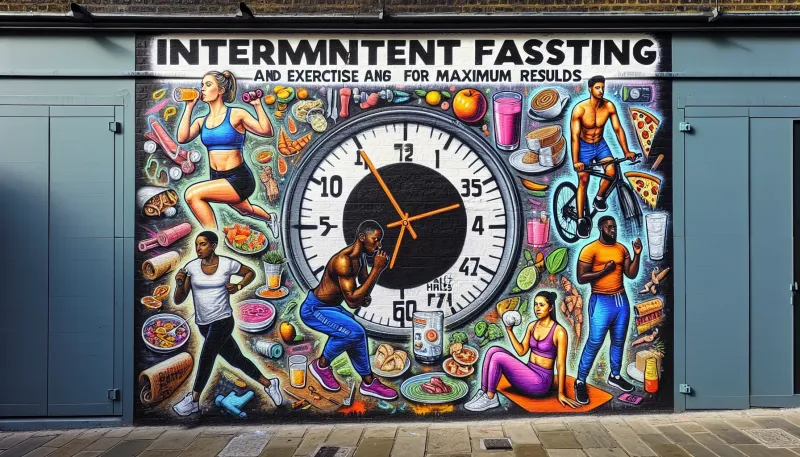The Ultimate Guide to Intermittent Fasting and Exercise for Maximum Results

Discover the ultimate guide to intermittent fasting and exercise, featuring expert advice and strategies to maximize your fitness results.
Intermittent Fasting and Exercise are two powerful tools that, when combined, can produce remarkable results for your health and fitness. This guide will provide you with comprehensive information to maximize your outcomes efficiently and safely.
What is Intermittent Fasting?
Intermittent fasting (IF) is an eating pattern that alternates between periods of fasting and eating. Unlike traditional diets that focus on what to eat, IF is more concerned with when to eat. The most common methods include the 16/8 method (fasting for 16 hours and eating during an 8-hour window) and the 5:2 method (eating normally for five days and restricting calories for two non-consecutive days).
Benefits of Intermittent Fasting
Research has shown several benefits associated with intermittent fasting:
- Weight Loss: IF helps in reducing calorie intake and boosting metabolism.
- Improved Insulin Sensitivity: Enhances the body’s response to insulin, lowering the risk of type 2 diabetes.
- Cellular Repair: Promotes autophagy, a process where cells remove damaged components.
- Brain Health: Increases levels of brain-derived neurotrophic factor (BDNF), promoting brain health.
- Longevity: Some studies suggest intermittent fasting may extend lifespan.
How Intermittent Fasting Affects Exercise Performance
Integrating intermittent fasting and exercise involves understanding how fasting impacts your workout. When done correctly, this combination can enhance both fat loss and muscle gain.
Exercising in a Fasted State
Fasted exercise generally means exercising after a period of fasting, typically in the morning before breakfast.
- Fat Loss: Fasted exercise can increase fat oxidation, helping reduce body fat percentage.
- Hormonal Benefits: Boosts levels of adrenaline and noradrenaline, enhancing energy and focus.
Potential Drawbacks of Fasted Exercise
While fasted exercise has benefits, it's essential to be aware of potential drawbacks:
- Reduced Performance: Lack of immediate energy can lead to decreased performance in high-intensity workouts.
- Muscle Loss: Risk of losing muscle mass if protein intake isn't adequate.
- Dizziness and Fatigue: The body may take time to adapt, causing temporary side effects.
Optimizing Your Workouts with Intermittent Fasting
Best Practices for Combining Intermittent Fasting and Exercise
Follow these tips for combining IF and exercise for maximal benefits:
Timing Your Workouts
Schedule your workouts towards the end of your fasting period, so you can eat shortly after. This helps replenish glycogen stores and promotes muscle repair.
Balanced Nutrition
Ensure your eating windows include a balanced diet with adequate protein, healthy fats, and complex carbohydrates to support your energy needs and muscle retention.
Stay Hydrated
Drink plenty of water throughout both fasting and eating periods. Proper hydration is crucial for performance and recovery.
Start Slow
If you’re new to IF, start with a less intensive exercise regimen. Give your body time to adapt before advancing to more demanding workouts.
Listening to Your Body
Pay attention to how your body responds to this combination. Adjust fasting periods and exercise intensity based on your energy levels and overall well-being.
Sample Intermittent Fasting and Exercise Plans
16/8 Method and Exercise
In the 16/8 method, fast for 16 hours and have an 8-hour eating window. Here’s a sample plan:
- 7:00 AM: Wake up and hydrate (no calories).
- 8:00 AM: Fasted low-intensity workout (e.g., walking, yoga).
- 12:00 PM: First meal (balanced and nutrient-rich).
- 3:00 PM: Second meal (light snack, high in protein).
- 6:00 PM: High-intensity workout.
- 7:00 PM: Post-workout meal (carbohydrates and protein).
- 8:00 PM: Begin fasting period.
5:2 Method and Exercise
In the 5:2 method, eat normally for five days and restrict calories (500-600) for two non-consecutive days. Here's a sample:
- Regular Eating Days:
- Exercise regularly focusing on strength and endurance training.
- Follow a balanced diet to fuel workouts.
- Fasting Days:
- Engage in light physical activities such as walking or stretching.
- Consume small, nutrient-dense meals to stay within calorie limits.
Final Thoughts
Combining Intermittent Fasting and Exercise can be a powerful strategy for improving your health, fitness, and overall well-being. By understanding the principles of each and how they interact, you can tailor a regimen that optimizes your results. Remember to be patient and listen to your body, making adjustments as needed. Always consult with a healthcare professional before starting any new diet or exercise program.



























